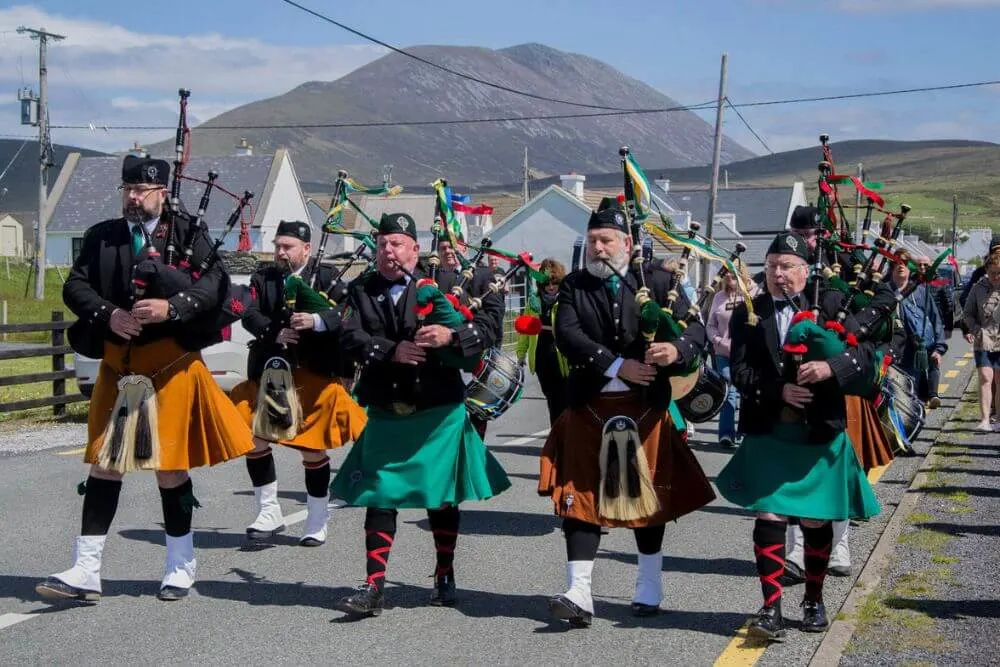
Table of Contents
Kilts in Ireland
The first thing that comes to mind when thinking of kilts are probably not Irish kilts but of Scottish kilts. Although originating in the Scottish Highlands, kilts do have some relevance in Irish culture too.
This article will tell you everything you need to know about Irish kilts: The Irish kilt history, Irish tartans, the difference between Scottish kilts and Irish kilts and a lot more.
It will also try to rectify some of the misconceptions that have been written about Irish kilts, such as that the Irish kilts history is shrouded in ancient mystery and that the Irish tartan kilt is a national traditional Irish attire.
Spoiler: both claims are not true.
Irish Kilts History
It is true: the origin of kilts lies in Scotland. Here the highland dress, also known as the belted plaid or great kilt (also known as feileadh mor meaning large wrap in Gaelic) emerged during the 16th century. The word kilt is a Scots word which means to tuck up clothes around one’s body. Originally, the great kilt was a full-length piece of clothing, which could even be worn as a cloak wrapped over the shoulder.
The history of kilts in Ireland is less ancient. In fact, Irish kilts are a modern invention, which nevertheless have their own right in Irish history. Some scholars date the earliest adoption of Scottish kilts by Irish nationalists in the 1850s.
By the end of the 19th century, Celtic Revivalists had more or less successfully adopted it as a symbol of Irish or Gaelic identity. During the “Gaelic Revival”, an Irish national consciousness began to grow and with it, the urge to counteract British colonial culture in Ireland.
Many areas of Irish culture were ‘rediscovered’, be it sports (the Gaelic Athletic Association aka the GAA), the Irish language, Irish literature, Irish arts and crafts and more.
In a nutshell: The Irish kilts history really begins with the Irish nationalist movement.
In the 20th century, at the dawn of the First World War, kilts were soon adopted by pipers and pipe bands in the Irish military (for example the still existing Black Raven Pipe Band or the Youghal Pipe Band). Pipe Bands were an important pool of nationalist recruitment, for example the Irish Volunteers (later transformed into the IRA).
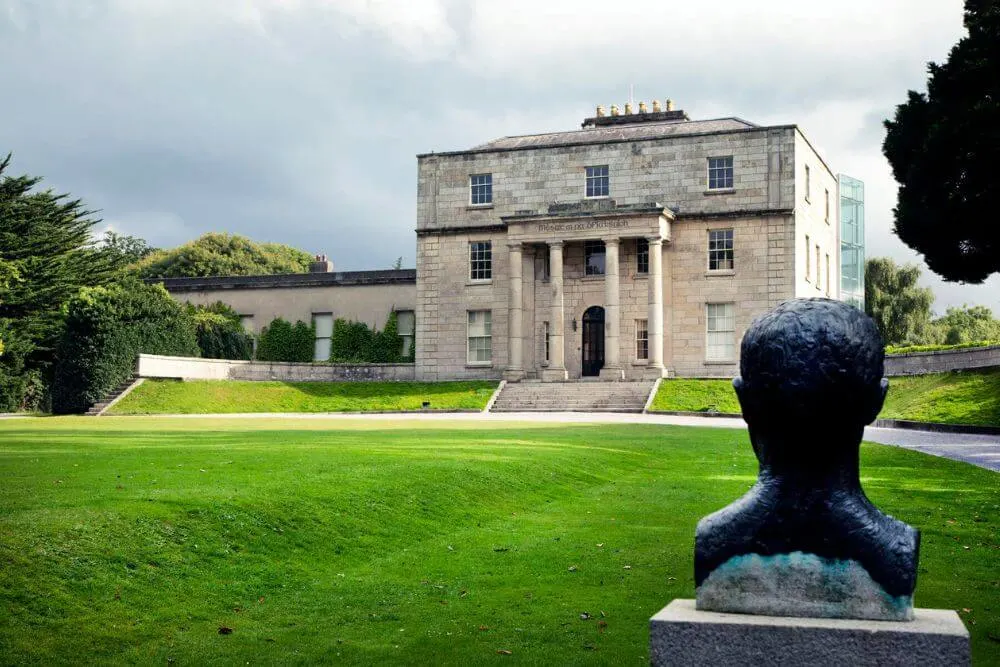
A famous promoter of the kilt was one of the leaders of the Easter Rising, Patrick Pearse. His school, St. Enda’s School for Boys (founded in 1908), attempted to “restore” an Irish educational system. Part of this was to adopt a “traditional” Irish dress.
Eventually, he adopted a saffron (aka mustard yellow) kilt as the uniform of the boys. In a letter in 1900 Pearse actually acknowledges the fact that kilts are not part of the Irish culture, but forcefully adopted to aid the idea of a Gaelic, non-English cultural identity: “Frankly I would much rather see you arrayed in a kilt, although it may be less authentic than in a pair of these trews.”
Around the same time, as Pearse introduced his Irish saffron kilt, pipers in Irish regiments of the British Army also began wearing saffron kilts. By the 1940s, the Irish pipers’ costume became the standard attire: saffron kilt, Irish green caubeeen and the brat or cloak.
If you want to read more in-depth about the Irish kilts history, we recommend the great article Hibernean Dress, Caledonian Custom on the website of the Scottish Tartans Museum.
Authentic Irish Tartan?
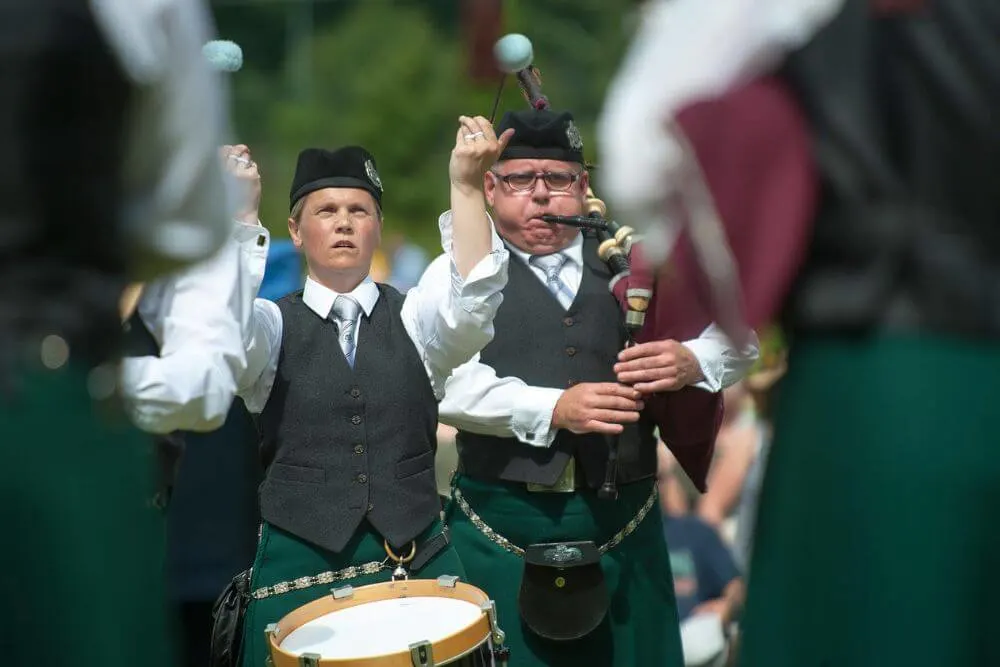
The short history should have shown that the Irish kilt is of solid colour, mostly saffron or green. That does not mean, however, that solid colour kilts originate in Ireland. In fact, they have been worn in Scotland ever since kilts existed, but have never been as popular as their tartan opposite.
At the same time, tartans have been worn in Ireland for centuries. Tartan was just a lot rarer, as it was more costly to produce. By definition tartan fabric is pure wool, often even premium wool.
There are different wool tartan weights. The medium weight tartan (about 13oz) is the most common one. Very often it was used for shawls or sashes and was only worn by Gaelic Chieftains or high-ranking soldiers.
But just because tartans were worn in Ireland does not make them Irish tartans. In fact, even the famous Dungiven outfit found near Derry in 1956 which dates to about 1600-1650 has been found to have been woven in Ireland, but tailored in Scotland.
So how come that there are so many search results online when searching for the following:
- Irish Tartans
- Irish Tartan kilts
- Ireland National Tartan
- Irish Tartans by surname
- Irish Tartans by county
- Irish Kilts by clan
There are Irish tartans, but they all date from a later time. The earliest known Irish tartan kilt is the Ulster tartan, which dates from 1958. Another one is the Tara Tartan, which was being sold in a kilt shop in Edinburgh in 1967.
The Irish tartans researcher D.C. Stewart comments on this phenomenon mentioning a company which “were taking some Scottish tartans, changing the colours and giving them Irish names.”
Irish tartans by surname or Irish county tartans (be it Irish kilts by county such as from County Cork, County Leitrim, County Limerick, County Monaghan, County Sligo, County Waterford or County Westmeath…yes…all these counties apparently have their own Irish county tartan…) are thus an invention by clever business men and women. These modern kilts can be dated from the 1960s to today.
In Ireland Irish tartans are not really popular and seldomly worn. Additionally, there is no Irish national tartan. The success of Irish tartans can rather be seen in the North American sphere.
Frequently asked questions on Irish kilts
Irish in Kilts – Do the Irish Wear Kilts?
The simple answer to the question ‘Do Irish People Wear Kilts?’ is yes: Irish people wear kilts. However, it depends on the occasion. If you are a piper in an Irish pipe band, you might wear a saffron kilt or sometimes also a tartan kilt.
Otherwise, it is very rare to see Irish in kilts in Ireland, as wearing kilts is rather a Caledonian custom.
Are Kilts Irish or Scottish?
If you ever wondered “Are Kilts Scottish or Irish”, then the answer is both: Kilts definitely originate in Scotland and have a far longer, richer and more acknowledged cultural heritage than the kilt in Ireland. Think of Bonnie Prince Charlie who wore tartan to affirm his Scottish identity back in the 1740s.
Btw: The original tartan jacket still exists and its style is now known as the Prince Charlie Jacket. Irish kilts emerged with the existence of the Gaelic Revival in the mid- to late 1800s as part of a Gaelic cultural attire that was seen as non-English.
What is the difference between Scottish and Irish Kilts?
There are two major differences between Scottish and Irish kilts.
- The first one is that Scottish kilts are mostly tartan, whereas Irish kilts are mostly of solid colour such as saffron or green.
- The second difference is that Scottish tartans represent and symbolise clans and families or surnames. This tradition of Irish family tartans has emerged in Ireland only from the 1960s onwards, particularly to foster a commercial industry in North America.
In a nutshell: Tartans to symbolise particular family names are not part of an old Irish heritage tradition.
How many different tartan are there?
There are estimated to be between 2.500 – 4.000 different Scottish tartans. Some websites offer a tartan finder, with which you can find and view tartans by surname, tartans by clan and more.
Buying kilts in Ireland – Where can I do this?
In all honesty, unless you have a strong connection to a pipe band in Ireland or are a piper yourself, better not buy an Irish kilt. Rather investigate getting an authentic Scottish tartan kilt. So if you ever come across an alleged Irish kilt for sale, question its origin and its cultural significance.
Did the Irish have tartans?
Irish people have been wearing tartans for centuries. However, these tartans were of Scottish origin. When you see Irish in kilts, then you mostly see solid colour kilts (mostly saffron or green).
Irish tartans, especially Irish tartans by surname, is a modern invention (from the 1960s onwards) mostly geared towards North American tourists.
What are Irish Kilt Accessories?
If you are looking for Irish kilt accessories for your Irish kilt outfit, you might want to have the following items:
Headgear
In Scotland you might see some men wearing headgear. The two types which are commonly used are the Balmoral and the Glengarry. Many men decided to go without headgear though.
Irish Sporran
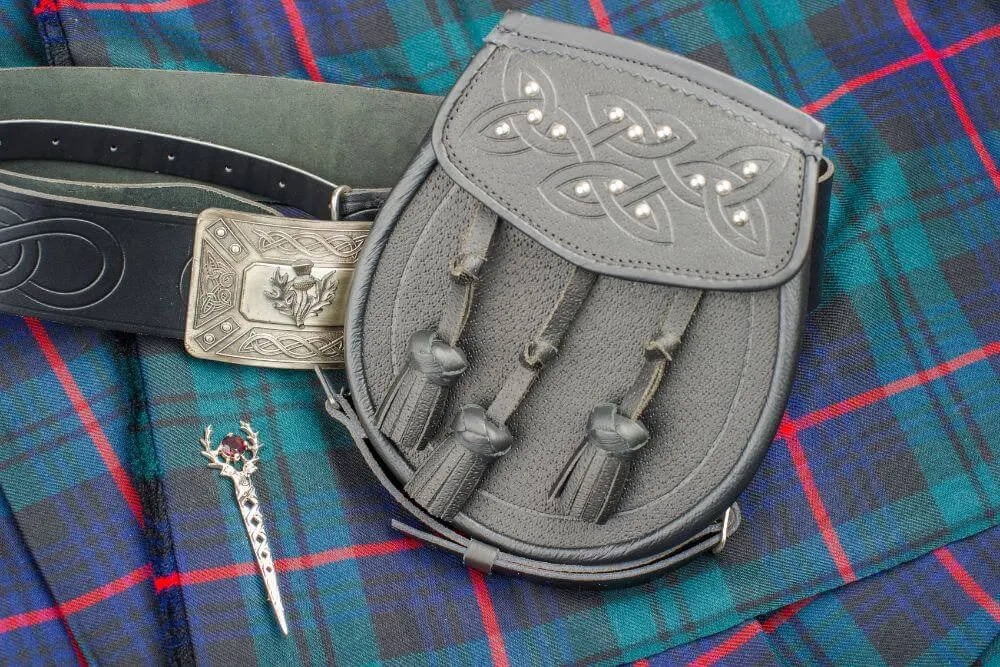
The sporran is part of the traditional kilt and is a pouch that functions as a kind of pocket (Although there is also a type of utility kilt, most kilts don’t have pockets). In Irish or Scottish Gaelic sporran means “purse”. Often it is made of fur or leather and ornamented in a way to complement the style of the kilt outfit.
Belt
Very often the buckle of the belt and the sporran are of a similar design to complement each other.
Kilt Pin
A kilt pin is an ornate accessory to highlight one’s heritage or affiliation. Usually kilt pins are worn in the lower right side of the kilt’s front. Some people have their personally designed kilt pins. Kilt pins are thus a great way to add a special touch to a kilt outfit.
Kilt Hose
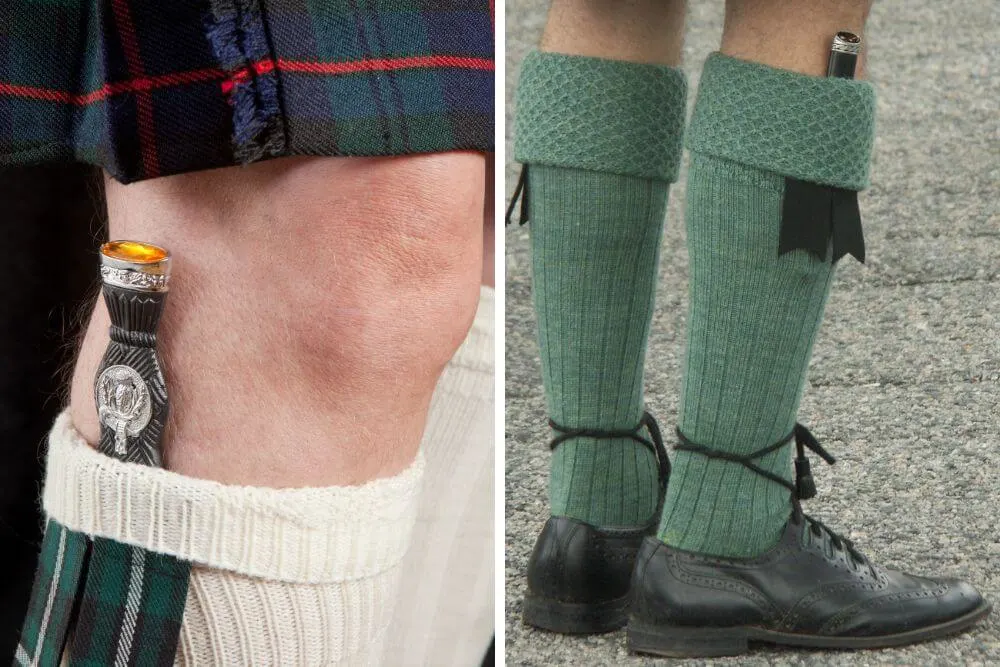
Kilt socks worn with a kilt are called hose and are mostly made from wool. They are traditionally knee high and can be adorned with decorative ribbons.
The Sgian Dubh
The Sgian Dubh is a relatively small single-edged blade or knife (in Scottish Gaelic sgian means knife) that is sometimes worn as part of the kilt attire.
The Brian Boru Jacket
The Brian Boru Jacket named after the Irish High king is a formal attire made from Barathea wool. It finishes in line with the waist in order not to hide any features of the kilt such as the sporran. Very often it is decorated with ornate buttons and cuffs.
The Kilkenny Jacket
Whereas the Brian Boru Jacket is more for formal occasions, the Kilkenny Jacket is more for casual occasions and is often seen in the colour green.
Ghillie Brogues
The traditional kilt shoe is the Ghillie Brogues. Mostly made of leather, also custom made Tartan Ghillie Brogues exist. You need a bit of practice to tie the brogues (Irish for shoes), as the laces wrap around your calf. This shoe is often used for dancing as well.
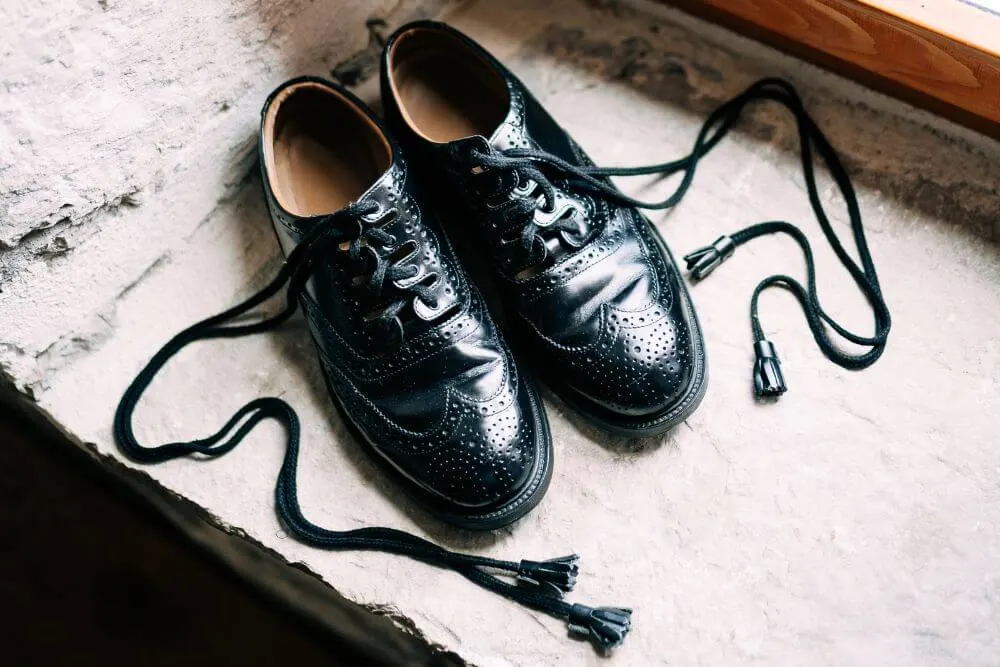
Scottish Kilts vs Irish Kilts
Hopefully this quick overview of the history of Irish kilts and kilts tartan popularity in Ireland have helped you.
Now you should be able to answer questions like ‘Do Irish wear kilts’ or ‘Is a kilt Irish or Scottish?’ and quickly even point out the differences between a Scottish kilt and an Irish kilt.
You also know that there is no such thing as an Irish national kilt or that the tradition of both Irish kilts by surname and Irish kilts by county, such as the County Cork tartan, is very young and has been motivated by clever sales people.
Feel free to drop us a line if you have any questions about Irish kilts.
